Albino Bats
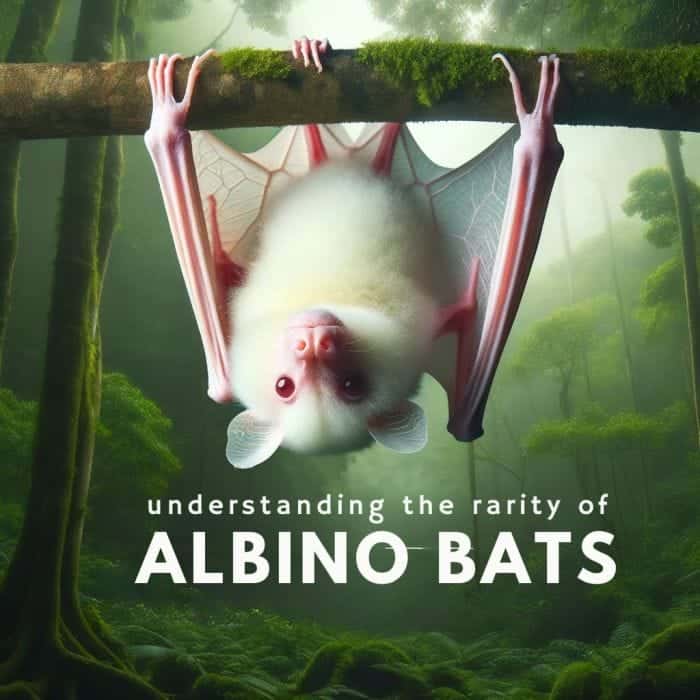
Albino bats are exceptionally rare in the wild, with only an estimated 4% of the over 1300 known bat species exhibiting albinism. However, cases of complete or partial albinism have been occasionally documented across 60 species in 11 chiropteran families on every continent except Antarctica.
Albinism is a genetic condition caused by mutations that inhibit the production of melanin pigment in skin, fur, and eyes. This results in the white fur and pink eyes that make albino animals like albino bats stand out from their normal-colored counterparts. While unusual, studying these unique albino individuals provides insights into bat genetics, habitats, behavior, and conservation.
This article will provide an extensive overview of our current understanding of these rare albino bats, including:
- Key statistics and background on reported cases.
- Genetic causes and inheritance patterns.
- Physical characteristics and geographic distributions.
- Ecological challenges faced by albino bats.
- Case studies of prominent albino bat discoveries.
- Conservation considerations for albino bat populations.
- Fun facts about Albino bats.
Jump to:
- Albinism Across Bat Species
- Geographic Distribution
- Family Breakdown
- Genetics of Albinism in Bats
- Types of Genetic mutations
- Inheritance Patterns in Bats
- Physical and Developmental Effects
- Physical Characteristics of Albino Bats
- Fur and Skin Coloration
- Eye Color and Vision
- Albino Bats Habitats and Geographic Distribution
- Habitats
- Geography
- White Bats vs. Albino Bats
- Challenges Faced by Albino Bats
- Predation and Survival Challenges
- Health Issues
- Notable Case Studies of Albino Bats
- Ethereal the Albino Microbat (2009)
- Albino Striped Spear-Nosed Bat (2015)
- Indian Desert Albino Bats (1970s-2000s)
- All-White Big-Eared Bat (2002)
- Partially Albino Chinese Horseshoe Bat of Borneo Forest (2015)
- Ghostly White Bent-Wing Bats Hanging Within Laotian Caves (2021)
- Impact of Albinism on Bat Behavior
- Social Structure Shifts
- Hunting and Navigation Challenges
- Captive Care Adaptations
- Fun Facts About Albino Bats
- Frequently Asked Questions
- What is an Albino Bat?
- Where can Albino Bats be found?
- How does the Albino Bat create its habitat?
- What do Albino Bats eat?
- What is the conservation status of the Albino Bat?
- When was the first Honduran White Bat discovered?
- How many species of tent-making bats are there?
- What is the preferred habitat of the Honduran White Bat?
- What are some distinct features of the Albino Bat?
- How do Albino Bats communicate?
Albinism Across Bat Species

Documented global cases of albinism have occurred across a diverse range of bat species. While even partial albinism is considered rare in bats, approximately 60 species from 11 chiropteran families have some reported cases in scientific literature. This represents under 5% of the more than 1,300 currently identified bat species worldwide.
Geographic Distribution
- The Americas: With around 29 species affected so far, the Americas account for almost half global known cases. Brazil itself documents albinism across 9 species like fringe-lipped bats. The USA’s heavy cave surveying uncovers rarities like albino gray myotis. Expanded monitoring continues filling North, South and Central American gaps.
- Europe: Old World cases initially centered in Europe, where 13 species host depigmented morphs so far, largely in cavern roosts like Slovenia’s karst caves sheltering an albino horseshoe bat. Iberian surveys find bull dog bats while Germany spotted fawn-white pipistrelles.
- Asia: From Japan’s orchid bats to Philippine dawn bats, Asia’s 12 impacted species also favor dark cave shelters offering sanctuary to rarities like India’s Thar Desert albino false vampire bats and all-white bent-wings lining Laotian grottoes. Malaysia’s rainforests newly revealed an albino island fruit bat.
- Africa & Australia: Data is still emerging from these continents, but isolated finds hint at broader ranges for albino megabats, while Rift Valley sites could harbor anomalously-hued insectivores much like India and Brazil‘s.
Suggested Reading:
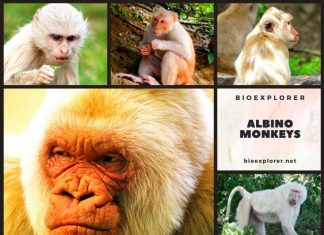
Albino Monkeys
Family Breakdown
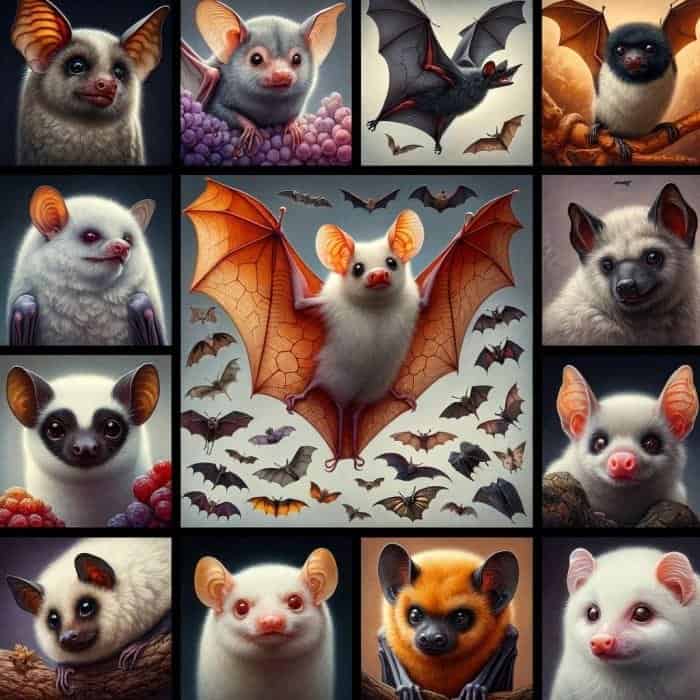
Some chiropteran families with higher recorded incidences of Albinism include:
- Phyllostomidae: With over 13 species affected, this diverse Neotropical group includes albino fruit-eating bats, nectar-feeders and the common vampire bat. Extensive surveys likely contribute to their representation.
- Vespertilionidae: This broad global group also accounts for over 24 known cases; Old-World bent-wings mix with New-World myotis bats and Argentina’s first document of albino Eptesicus furinalis.
- Molossidae: At least 9 documented cases span this family’s insectivorous free-tails and allies, involving tiny Tomopeas bats to heavy-bodied Brazilian bonneted bats and Cuban Promops centralis.
- Hipposideridae: Old World tropical roundleaf bats from Malaysian and Indian forests join South American relatives like the striped spear-nosed bat in this family with Old and New World covers that could hide more cavern surprises.
While temperate regions have historically had more intensive bat research, expanded studies across tropical zones have uncovered a greater diversity of albino bat species in families like Phyllostomidae. However, albinism likely still confers disadvantages to survival in the wild, keeping global occurrences relatively low.
![]()
Genetics of Albinism in Bats
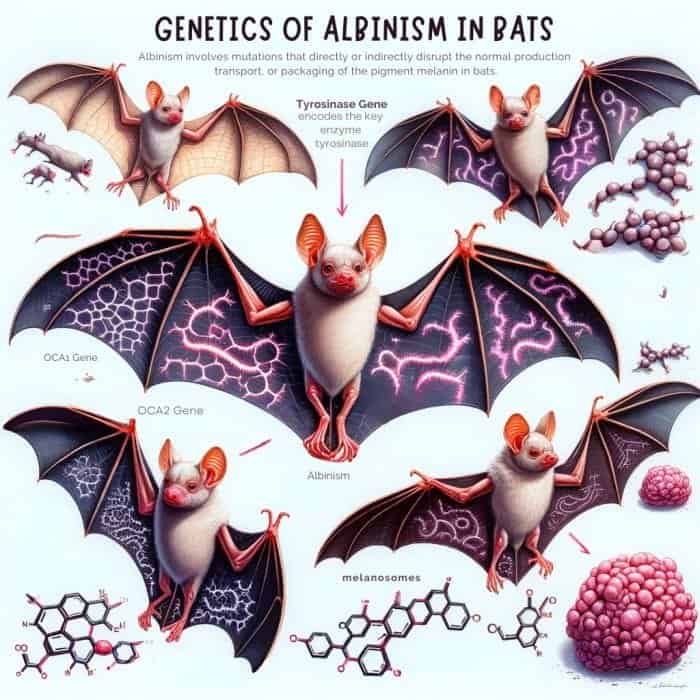
The underlying genetic causes of albinism involve mutations that directly or indirectly disrupt the normal production, transport, or packaging of the pigment melanin in bats. This results in a partial or complete lack of melanin pigmentation in the skin, fur, feathers, and eyes.
Types of Genetic mutations
- Over 100 types of genetic mutations have been associated with albinism across species. Most involve gene mutations that provide instructions for making proteins directly involved in melanin production in specialized cellular organelles called melanosomesWhat is melanosomes?Melanosomes are small organelles in melanocytes that produce, store, and transport melanin, the pigment coloring skin, hair, and eyes..
- The tyrosinase gene encodes the key enzyme tyrosinase, which catalyzes the first step in melanin synthesis. Mutations in the OCA1What is OCA1?The OCA1 gene, standing for Oculocutaneous Albinism Type 1, is responsible for producing tyrosinase, an enzyme essential for melanin production, and mutations in this gene can cause albinism. and OCA2What is OCA2?The OCA2 gene, standing for Oculocutaneous Albinism Type 2, plays a key role in melanin production, and mutations in this gene can lead to a form of albinism characterized by reduced pigmentation. genes that help regulate tyrosinase are common genetic causes of albinism.
- Other mutations can affect genes coding transport proteins that move melanosomes.
Inheritance Patterns in Bats
Patterns of inheritance for albinism in bats can be complex.
- Both autosomal recessive and sex-linked recessive inheritance have been documented. This results in some “carrier” bats that contain a mutated copy of the gene and a working copy, appearing normally pigmented.
- If two carrier bats mate, there is a 25% chance of albino offspring in each litter who inherit mutated copies from both parents. High carrier rates likely facilitate the persistence of albinism genes in bat populations despite disadvantages for the survival of albino individuals.
Physical and Developmental Effects
The lack of melanin pigment inhibits normal eye development and leaves skin vulnerable to damage from unfiltered sunlight. Optimal roosting habitats that limit light exposure are important for the health of albino bat populations under human care.
![]()
Physical Characteristics of Albino Bats

The most prominent features that stand out in albino bats compared to normally pigmented bats are the white fur/skin and reddish-pink eyes. However, the specific degree of pigment loss and manifestation of traits can vary substantially.
Fur and Skin Coloration
- Complete or “total” albinos exhibit pure white fur and skin covering the entire body surface, including wings and membranes. This complete loss of melanin pigment stems from mutations impacting pigment cell (melanocyteWhat is melanocyte?A melanocyte is a cell that produces melanin, the pigment responsible for color in skin, hair, and eyes.) development.
- With incomplete or “partial” albinism, pigmentation is reduced to varying degrees rather than eliminated. Small patches of normally colored fur may remain, creating a “pied” pattern, while the irises often retain enough pigment to keep a dark brown or blue coloration rather than appearing red/pink.
- Temperature-sensitive albinism mutations result in more albino traits in the coolest regions of the body surface. This phenomenon causes “point” coloration seen in Siamese cats, with the most depigmented legs, tail, ears, and face appearing.
Eye Color and Vision
- Complete loss of iris pigmentation results in red/pink irises due to visualization of the unmasked blood vessels below. Lack of pigment in the retinal epithelium also reduces optic capability.
- Partial albinistic bats may retain enough iris pigment for dark brown or blue irises depending on the type and location of genetic mutations impacting melanin synthesis pathways.
- Regardless of eye color, visual development issues are common due to a lack of pigment in the optical muscles and nerves. This results in reduced visual acuity, depth perception, and photosensitivity.
![]()
Albino Bats Habitats and Geographic Distribution
The research case studies highlight some trends in habitats and geographic hotspots where albino bats have been documented. Sheltered roost sites and certain concentrated regions appear common.
Habitats
Many recorded albino bats have been found taking refuge in enclosed, dark roosting sites offering protection from light exposure and aerial predators that could easily spot their pale coloration. These include:
- Cave systems like those housing albino variants of Myotis sodalis and Eptesicus fuscus.
- Hollow trees, the prime shelter for the albinistic striped spear-nosed bat.
- Mines and tunnels providing dark isolation as seen with Eptesicus serotinus.
- Abandoned structures also utilized by species like Molossus molossus.
Suggested Reading:
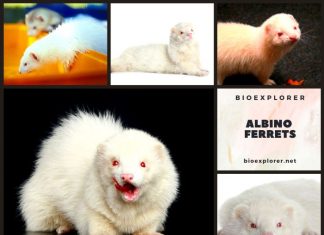
Albino Ferrets
Geography
North and South America have the highest published occurrence rates, with 14 albino species each, potentially reflecting research emphasis. However, expanding Neotropical surveys uncover growing cases like the albinistic great fruit-eating bat from Brazil’s Atlantic Forest.
Europe also shows extensive albino findings, especially from cave and roost surveys supporting large bat colonies. Slovenia’s Karst caves recently revealed an albinistic lesser horseshoe bat for the first time. Asia reports similar trends across enclosed shelters. Further cases likely await future discovery in Africa, Australia, and island systems.
![]()
White Bats vs. Albino Bats
There can be confusion between truly albino bats which lack all pigment due to genetic mutations vs. bat species that naturally exhibit white coloration. Here are some of the key differences:
| Reason for Color | Naturally evolved white fur, matching habitat. Examples: Honduran white bat, northern ghost bat. | Genetic mutation resulting in melanin loss |
| Genetics | Normal pigment-producing genes | Recessive mutations disabling pigment enzymes |
| Population Share | Entire species population exhibits white fur | Very rare albino mutations within predominately dark populations |
| Camouflage | Blends into white/light cave substrates | Contrasts against darker bat colony backdrops |
| Health Issues | No related health challenges | Sensitive to overexposure, cancers without melanin protection |
| Conservation Status | Stable populations, some forest-dependent | Vulnerable rarities needing unique provisions |
![]()
In summary, naturally white species thrive camouflaged in specialized light caves/habitats and have stable populations, while albino bats are exceptionally rare mutants within darker colonies and require provisions to counteract disadvantages.
Suggested Reading:
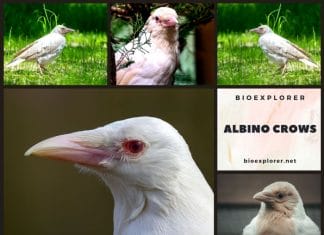
Albino Crows
Challenges Faced by Albino Bats
The lack of protective melanin and associated developmental issues pose key survival and health challenges for albino bats compared to normally pigmented bats.
Predation and Survival Challenges
- Higher visibility makes albino bats easier targets for predatory birds and other species.
- Reduced visual acuity also impairs navigation and foraging capabilities.
- Lower mating success means fewer opportunities to pass down albino genes.
Suggested Reading:

Albino Deer: A Rare and Fascinating Genetic Mutation
Health Issues
- Solar radiation damage to skin increases susceptibility to cancers/injuries.
- Vision impairment, even in the shade, creates navigation difficulties.
- Possible neurological issues like photosensitivity or developmental defects.
Yet, the persistence of albino carriers plus some flourishing colonies in protected settings demonstrate that adaptive roosting and community support can facilitate managing these conditions.
![]()
Notable Case Studies of Albino Bats
From a tiny albino microbat to all-white desert dwellers, the research uncovered remarkable stories of albino bats defying the odds.
Here are some of the prominent Albino bats documented:
Ethereal the Albino Microbat (2009)
In August 2009 in Texas, a rare albino juvenile microbat named Ethereal was rescued while seeking refuge at the Bat World Sanctuary. With completely white fur and red eyes, she became known for her sweet personality before passing later that year.
Albino Striped Spear-Nosed Bat (2015)
A 2015 Brazilian ecological survey documented the first observed case of albinism in the striped spear-nosed bat. Despite red eyes and extensive white fur, the mature albino male showed typical forearm and weight measures compared to his peers.
Indian Desert Albino Bats (1970s-2000s)
India’s Thar desert revealed surprise albino variants of the lesser rat-tailed bat and the greater false vampire bat in the 1970s-2000s. These findings proved albino bats can arise even among typically darker species living in harsh, extreme environments.
All-White Big-Eared Bat (2002)
In 2002, cavers exploring El Cajete Cave were astonished to spot a plump albino western big-eared bat roosting among otherwise normally tawny-brown peers. Contrasted against the granite walls, her completely chalk-white fur and bright pink ears gleamed under headlamps.
Partially Albino Chinese Horseshoe Bat of Borneo Forest (2015)
Bat surveys 2015 of Bako National Park in Malaysian Borneo uncovered a partially albino female roundleaf horseshoe bat roosting amid typically russet-furred kin. While missing pigmentation on the body, its wings, and shoulder fur retained normal hues, creating stark contrasts that likely reduced but didn’t eliminate camouflage against foliage and bark.
Ghostly White Bent-Wing Bats Hanging Within Laotian Caves (2021)
Explorers in 2021 spelunking within remote karst caves of Laos encountered an eerie scene of multiple chalk-white bent-wing bats lining cave ceilings amongst otherwise soot-black colony clusters. These hanging albino morphs stood out starkly in surveys yet somehow persisted in etching out an existence in the darkness of the caverns despite their glaring visibility against darker walls and ceilings.
![]()
Impact of Albinism on Bat Behavior
The genetic condition of albinism can significantly influence bat behavior compared to normally pigmented populations, affecting social dynamics, hunting capabilities, and navigation.
Social Structure Shifts
Complete societal rejection is uncommon, but albino bats often face isolation or small subgroup formation within larger mixed colonies. All-albino clusters exhibit extensive grooming and huddling behaviors that facilitate communal bonds that are otherwise rare for bat species. Studying such groups reveals how social activities shift when albinism is the localized norm.
Hunting and Navigation Challenges
The stark white fur of albino bats eliminates the natural camouflage used during aerial insect foraging by most microbats, though albino fruit-eating bats prove more adept hunters. Regardless of diet, optical development issues create navigational impairments for many albino bats. Reduced orientation ability can impact critical food-acquiring and shelter-returning journeys even within light-controlled habitats.
Captive Care Adaptations
Providing enriched roosting spaces with ample food access helps compensate for the heightened vulnerabilities of albino bats under human care. While mating and overall activity levels often decrease, zoo colonies facilitate social reintegration and spotlight how supportive conditions allow surviving albino bats to find security.
![]()
Fun Facts About Albino Bats
- Moonlight Fliers: An albino pallid bat was once observed fluttering under the glow of a bright Midwestern harvest moon, its translucent wings glowing ethereally in the lunar light. Though albino bats can struggle to hunt via echolocation, their visibility under moonlight offers alternative periods for successful insect chasing.
- Daytime Disk-Wing Spottings: Researchers were astonished to observe a fully albino southern disk-winged bat roosting fully exposed along an Amazonian rainforest stream bank amid normally chocolate and cream-furred kin during daylight hours. Despite pigment-loss disadvantages, record numbers of this fruit-eating species imply albino bats find survival pathways.
- From Vampires to Golden Hues: Brazil’s 17 known albino bats span diminutive orange-furred fruit bats to imposing white-furred vampire bats. Over 60% reached maturity, suggesting habitat protections like dark, enclosed roost sites can facilitate albino lifespans comparable to normal bats despite the mutation.
- Cavern Dwelling Caveoples: Research in Slovenia uncovered an entirely albino lesser horseshoe bat tucked amid typically gray-furred kin clinging to a karst cavern ceiling. Such enclosed underground sites likely enable these “cave peoples” to escape the largest pigment-loss threats from aerial spotting and sun exposure outside of sleeping hours.
- Flavistic Fruit Bat Femme: An anomaly female dawn bat on India’s Nicobar Islands stood out from her chestnut comrades not only due to white fur patches but also bright golden yellow hues resembling flavism disorders. However, this cocktail coloration didn’t impede her presence during surveys, hinting at resilience.
![]()
Frequently Asked Questions
What is an Albino Bat?
An albino bat is an individual that exhibits complete absence of melanin pigmentation in the fur, skin and eyes due to genetic mutations that disrupt the production or distribution of melanin.
Where can Albino Bats be found?
Albino bats have been documented on every continent except Antarctica, but tend to concentrate in tropical caverns, old forests with ample hollow trees, mines and other shelters offering protection for light-sensitive bats without natural pigment protection.
How does the Albino Bat create its habitat?
Albino bats do not create habitats themselves. They depend on natural shelters like caves and tree hollows or man-made structures that provide the dark, enclosed spaces able to compensate for the extreme light sensitivity and vulnerability that accompany albinism in bats.
What do Albino Bats eat?
Albino bats eat the same insects, fruit, nectar, pollen or blood that non-albino bats of their particular species consume. Lack of camouflage can hamper albino insect-eating bats, but provisions of ample sheltered roosts with nearby fruit or nectar resources can help compensate. Explore what do bats eat here.
What is the conservation status of the Albino Bat?
There are no current at-risk categorizations specific to albino bats. But their extreme rarity and vulnerabilities means that provisions to shelter known colonies and roost sites supporting documented albino bats represents important localized conservation efforts for these unique genetic morphs. Securing habitats that facilitate albino survival also aids related vulnerable bat species.
When was the first Honduran White Bat discovered?
The first discovery of the Honduran White Bat dates back to 1898. The species is unique due to its bright white color and its habitat-building behavior.
How many species of tent-making bats are there?
There are two known species of tent-making bats, namely Dermanura Watsoni and Ectophylla Alba, both of which exhibit tent-making behavior to create their roosting spots.
What is the preferred habitat of the Honduran White Bat?
The Honduran White Bat prefers to roost within and near the Heliconia plant, often forming their distinctive white-roofed tents with the large leaves of the plant.
What are some distinct features of the Albino Bat?
Distinct features of albino bats compared to normally pigmented bats include white fur and skin, bright red/pink eyes, and pale ears and wing membranes. They also exhibit genetic mutations leading to metabolic issues with melanin synthesis and often have visual development impairments. Their stark appearance makes them stand out against darker backgrounds.
How do Albino Bats communicate?
Albino bats communicate using the same species-specific methods of echolocation, scent markings, vocalizations and physical gestures that non-albino bats utilize. Insects gleans may rely more on passive sound detection versus adjusted echo-based prey pursuit strategies. But albino bats appear to maintain social integration when possible through standard bat call exchanges and contact.
![]()
While a rare phenomenon, the approximately 60 albino bat species documented so far offer intimate glimpses into genetics, behavior, and conservation sciences.
From genetic mechanisms producing pigment-loss mutations to revelations like successful albino female breeding, examining these unique white-coated bats pushes knowledge boundaries. Ethical rescue efforts reveal care tactics aiding survival outside natural dark haven shelters.
Expanding global surveys and cave explorations will likely uncover more albino bat tales awaiting within uncharted forests and caverns. Each new albino discovery spotlights adaptation marvels while driving home shared duties to look out for such vulnerable rarities within an increasingly development-pressed natural world.
![]()
Cite this page
Bio Explorer. (2026, January 6). Albino Bats. https://www.bioexplorer.net/animals/mammals/albino-bats/


